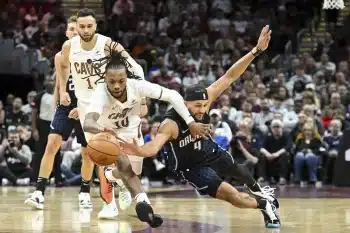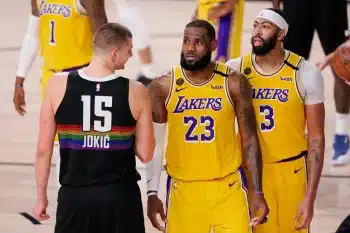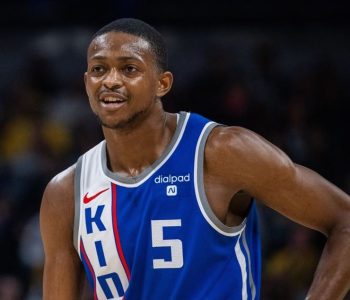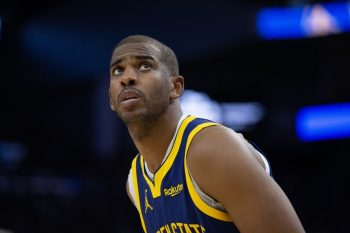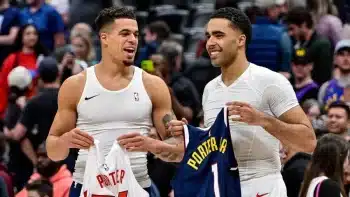NBA
NBA AM: Are Kings Open To Moving Cousins?

Moving DeMarcus?: There is a popular narrative that’s been floating around the NBA since roughly the All-Star break and as that story goes, Sacramento Kings center DeMarcus Cousins is unhappy and the Kings might explore his trade value this offseason.
In part, some of that might be true, but according to sources close to the situation Cousins isn’t pushing for a trade and is prepared to give head coach George Karl a chance to make all of this work next season. From there, all bets are off.
The Kings gave Cousins a list of things they’d like for him to work on – things like being around the team as much as he is comfortable and being one of the leaders of the team when they open summer league and start bringing in new faces.
For Cousin’s part, he’s not ready to ask for a trade and he seems open to what’s being suggested regarding his role and the future of the team. Admittedly there was some broken trust in how the team handled the firing of former head coach Mike Malone, but Cousins, according to sources, isn’t ready to jump ship.
That said, all in not fine in Candyland. Cousins, like many younger players in this kind of situation, wants to win and hasn’t been blown away with the moves and the direction the team has taken in the last year. If things don’t start to turn the corner, it will get harder and harder to get him to buy in and no one wants to be involved with an unhappy Cousins.
There are a number of teams that would be willing to trade for Cousins, but at this point it does not look like the Kings will actively engage on trade talks with Cousins, or at least that’s what they have said to others who have asked.
That doesn’t mean someone won’t park a whopper of an offer on the table to try and tempt the Kings into a deal, but the current stance is to give everything a full year under Karl and see where things land.
If the losing and dysfunction continue, it’s not out of the realm of possibility that a mid-season trade around the trade deadline gets pondered, but with Cousins having three more fully guaranteed contract years on his deal, beyond being grumpy, the Kings have time to figure things out.
As things stand today, the Kings have roughly $53.1 million in firm salary commitments, which does not include the $16.662 million cap hold on former second overall pick Derrick Williams. Assuming the Kings renounce him or ink a new deal at a lesser amount quickly, they may not have much more than $12-13 million in salary cap room to work with this summer. While that’s not an insignificant number, it takes them out of the max contract race and leaves them behind several other teams with more to spend.
The Kings for the last two years have been trying to off-load Jason Thompson, who is owed $6.43 million next season. There is also a possibility that last year’s first round pick Nik Stauskas could be moved around the draft.
The Kings have some options and sources close to the situation say they will be aggressive, but moving Cousins doesn’t seem to be in the plans. Trying to improve the roster around him seems to be the first order of business.
The Decline Of The Draft Combine: Yesterday in this space we covered some of the changes in the NBA Combine process that will get underway next week in Chicago, the biggest being the return of five-on-five play to the court portion of the process. While the Combine has a tremendous amount of value, it seems meaningful to re-state what really happens at the Combine.
Face To Face Team Interviews
The area teams seem to value the most is the face-to-face interview time. This is much like a job interview where teams are assigned small meeting rooms and they can request up to 18 players to meet with. This becomes a meaningful touch point for teams that may have interest in trading up or trading down, as most agents won’t waste a workout day on a team that’s not in their client’s projected range. Teams can request whomever they want; in previous years, the Spurs have requested players at the top of the draft despite not having a pick anywhere near it. This allows the team to meet the player, dig into the personal parts and make decisions.
Players are under no obligation to attend an interview session and some do skip teams they have no interest in meeting with or feel that the meeting isn’t about their draft stock. It’s not at all uncommon to see a player just sitting in the interview area waiting for their next interview after skipping a previous one.
No two use the interview time the same way. Some make it very causal and informal, some have each player filling out paperwork such as a psychology test. One year, the Lakers had a computer terminal and a person administering a test and that was their interview session. Last year, during a Knicks interview, Phil Jackson openly questioned the wingspan of Jarnell Stokes, telling him to stand up and prove it.
As one executive explained, his team rarely considers anyone they meet with a draft candidate, but uses that time to make sure they have met with everyone they like, if only to start a file for some point in the future when they may want to sign that player as a free agent or obtain him in trade.
The face to face portion of the Combine begins Wednesday night and spans three days.
On-Court Work
The on-court portion has been a problem for some time. As a compromise to get more players to attend and participate, the format was turned into drills. These drills where often low impact and low value drills that rarely helped a player’s draft stock. Executives often joked about how much one could learn from watching guy run around cones, but they still showed up because that’s what they had to watch.
This year the on-court portion is returning to a five-on-five format, with players ranked in the top 20 being designated as “interview and medical testing only” – meaning they are not being asked to participate in the games. That does not mean a player couldn’t ask to participate, but the belief is none of them would so the process is moving on. Now the wrinkle is if a player was not designated as an “interview and medical testing only” player, they must agree to participate or they would not be allowed to attend the other components of the process.
This has yielded some gray area players that are not willing to play, but want to meet with teams and complete the medical. If those players won’t agree, they’ll get bumped in favor of players who will. Normally the invite list of the Combine is a good barometer of who will get drafted – in previous years about 88 percent of the players who were invited got drafted – but that figure likely changes if draftable players opt not to attend.
What’s expected to take place this year is four to five teams of 10 players that will play games for two days. Executives want five-on-five and this will be the only setting this year for that to happen. In individual workouts with teams, draft eligible players are not permitted to compete in anything more than three-on-three.
This new format will be far more meaningful for the second-tier players than the top tier, and considering the top tier usually did not compete anyway this new system will hopefully yield a more meaningful evaluation for teams.
Physical Measuring And Testing
One of the more popular portions of the Combine is the physical testing. This testing is where all aspects of a player are measured, including their speed, vertical and agility as well as physical dimensions like height, wingspan and even hands size.
Most of this is trivial, but in a data driven world the more data the better and teams use the data in a lot of different ways.
There is no doubting that height and wingspan matter in the NBA, as does hand size. Players with small hands tend to be poor rebounders, so there are things to be gleamed from the numbers. But as the executives will point out, Chris Paul logged a terrible 3.4 court sprint time, Kevin Durant couldn’t bench press the bar and Paul Millsap measured in terribly, but all turned out to be exceptional NBA players. Like all tools, physical testing is just one small part of a much bigger evaluation process and all players are encouraged to be tested the same way, to unify the results.
Meeting With The Media
The media does play a role in the Combine process, albeit not an overly significant one. This is where players, especially the lesser known guys, get to tell their story and generate some buzz about their candidacy as a draft pick.
Last year, Dante Exum attended and was a hit with the media and really moved himself from the “man of mystery” label to a known quantity. After the Combine, he was considered a candidate for the top overall pick and a number of teams considered him a little more after getting a chance to see how he handled himself.
Exposure is good, it helps sell the idea of a player and for the most part seeing how a player handled the scrutiny of the media does weigh into the process – particularly for teams with a more aggressive media base, who need to understand how a player is going to handle the horde.
In-Depth Medical
One of the more important components to the Combine is the unified medical evaluations. Every player goes through a battery of tests including detailed blood work, a full body MRI and in-depth heart and cardiovascular testing. When you hear about a player being red flagged, this is usually where it happens and it’s usually a big reason why some players opt to skip the Combine altogether.
It’s nearly impossible to get drafted in the NBA without a robust medical exam, so whether that’s done at the Combine or by the team itself or by the players’ agent and circulated to teams of their choosing, failing to take the medical will impact draft status.
Every year, there is a player who opts not to take the medical or skip the Combine and that in and of itself red flags the player.
Teams value this medical information because it’s uniform; it’s done by impartial doctors and is incredibly thorough. It also provides an early look at a potential problem that a team can then debate the risk of, and then follow up during their own work outs.
The Indiana Pacers were fully aware of former forward Danny Granger’s knee issues prior to drafting him. They explored the knee thoroughly and decided they could manage the knee and ultimately drafted him when so many other teams red flagged the knee and passed.
So while the Combine offers a tremendous value for teams and a large swath of players, it is not overly meaningful for players at the very top of the draft board. As we saw last year when top picks Andrew Wiggins, Jabari Parker and Joel Embiid opted to skip the Combine, it did not impact their appeal, draftability or earning potential. All three signed lucrative shoe deals and all three received the high-end of their rookie scale contracts.
The same will be true of Jahlil Okafor, Karl Towns, Emmanuel Mudiay and D’Angelo Russell. There is some PR value to being seen and paraded around. There is some value to getting the medical done and meeting with teams outside the top five if they seem willing to try and trade up.
However, the Combine isn’t about the top of the board, it’s about the middle and the bottom. The teams at the top of the board have been scouting these players for months, many have already started having conversations with agents and some have already met and sat with the players.
The key in the draft process is finding your floor, that pick you will no go past. The top of the draft board likely knows where their floor is, so now it’s about risk and exposure. If Towns were to play in the five-on-five and tear his ACL what happens next? It’s risky and unnecessary when you are as well regarded as he is.
So if the top of the draft board opts to skip the Combine, they are not risking anything; in fact, they are simply protecting and controlling the process as much as they can because there is nothing really gained for them at the Combine. And everyone in the process is OK with that, because the Combine is not about the top of the draft board.
More Twitter: Make sure you are following all of our guys on Twitter to ensure you are getting the very latest from our team: @stevekylerNBA, @AlexKennedyNBA, @LangGreene, @EricPincus, @joelbrigham, @SusanBible @TommyBeer, @JabariDavisNBA , @MokeHamilton , @JCameratoNBA, @iamdpick, @jblancartenba, @CodyTaylorNBA and @YannisNBA.
